Coupling Coordination Relationship and Evolution Prediction of Water-Energy-Food-Wetland Systems: A Case Study of Jiangxi Province
Abstract
1. Introduction
2. Materials and Methods
2.1. Study Area
2.2. Theoretical Framework
2.3. Construction of the Index System and Data Sources
2.4. Evaluation Method
2.4.1. The GRA-TOPSIS Model
2.4.2. CCD Model
2.5. Geographical Detector Model
2.6. GM (1,1) Forecasting Model
3. Results
3.1. The Comprehensive Performance Evaluation Result of the WEFW System
3.2. Analysis of Coupling and Coordinated Development of WEFW Systems
3.2.1. Coupling and Coordination Degree Between Wetlands and Other Subsystems
3.2.2. CCD of WEFW
3.2.3. Comparative Analysis of Coupling and Coordination Relationship Between WEFW and WEF Systems
3.3. Analysis of the Contribution Degree of Each System in WEFW to the CCD
3.4. Prediction Results of Coupled Coordination Based on GM (1,1) Model
4. Optimization of Wetland Protection and Resource Management in Jiangxi Province Based on the Coupling and Coordination Development of WEFW Systems
- 1.
- Strengthen wetland restoration and ecological barrier construction: Referencing the U.S.’s experience in market-oriented ecological compensation and India’s model of linking wetlands with eco-agriculture, Jiangxi could further explore market mechanisms to balance protection and resource utilization. Based on the economic value assessment of wetland ecological services, it is suggested that the wetland carbon sink be included in the provincial carbon trading market, and that a subsidy of 50–60 yuan per ton of CO2 is provided to the entities responsible for wetland restoration; at the same time, Jiangxi could establish a “microclimate regulation benefit compensation mechanism”, where the agricultural and energy enterprises that benefit contribute funds proportionally for wetland protection, for example, extracting special protection funds based on 5% of the lost income due to reduced farmland production and 3% of the energy enterprise’s energy-saving benefits, forming a “protection–benefit–feedback” virtuous cycle. Addressing the degradation of wetlands across the province, Jiangxi could implement re-wetland farming projects, with a focus on restoring degraded wetlands around Poyang Lake, construct native plant buffer zones such as reeds and bulrushes along the wetland edges to enhance water conservation capacity [69,70], and reduce the impact of agricultural non-point source pollution on wetland ecology.
- 2.
- Promote coordinated utilization of WEFW: Promote the development of wetland biomass energy, build distributed biogas projects around cities such as Nanchang and Jiujiang, utilize waste such as reeds and algae to produce biogas, reduce reliance on fossil energy; in grain-producing areas such as Ganzhou and Ji’an, rely on wetlands to intercept agricultural non-point source pollution and reduce water treatment energy consumption and carbon emissions [71].
- 3.
- Establish a dynamic monitoring and cross-departmental coordination mechanism: Establish a provincial wetland ecological monitoring network to track changes in wetland area, water quality, and carbon sink capacity in real time; establish a “water-energy-food-wetland” collaborative management office to integrate the functions of water conservancy, agriculture, and energy departments; formulate unified wetland protection and resource utilization plans; and conduct a WEFW system CCD assessment every three years and dynamically adjust policies.
- 4.
- Improve ecological compensation and social participation: Promote the “wetland bank” model, encourage enterprises/individuals to obtain compensation such as carbon sink trading or water resource usage rights through wetland restoration [72], and enhance social participation; explore the realization path of wetland ecological product value, forming a “protection-revenue” virtuous cycle.
5. Conclusions
- From 2001 to 2022, the comprehensive evaluation of the WEFW systems in all cities of Jiangxi Province showed an overall upward trend, with significant improvements in Fuzhou, Yichun, Ganzhou, and Ji’an (e.g., Ji’an’s evaluation value rose from 0.518 in 2018 to 0.563 in 2022). However, regional development was unbalanced: large and medium-sized cities such as Nanchang and Jiujiang maintained a high level for a long time, while cities like Jingdezhen and Xinyu had lower evaluation values.
- The CCDs of wetlands with water, energy, and food experienced a process of “stability-fluctuation-recovery”. They significantly recovered after 2014, with distinct spatial differentiation characteristics: the coordination degree in Nanchang and Jiujiang remained stable in the high-quality category (>0.75); in Ganzhou and Pingxiang, it fluctuated sharply (0.55–0.70); in Shangrao and Yichun, it increased to the good category (0.65–0.75).
- Wetlands were the dominant factor in the spatial differentiation of CCD, with a contribution significantly higher than other subsystems. Mantel test and geographical detector analysis showed that wetlands had a strong explanatory power for the CCD; their interaction with water resources exhibited a strong nonlinear enhancement effect (highlighting the key role of wetlands in water resource management), and their interactions with energy and food were also significant. This further proves the importance of wetlands in ecosystem services and agricultural production and emphasizes the significance of wetland protection for the coordinated development of WEF.
- Predictions indicate that the CCD of the WEFW system in Jiangxi Province will rise steadily from 2022 to 2032, with significant growth in Fuzhou, Ganzhou, and Ji’an (the coordination degree is expected to reach 0.71 and 0.73, respectively, in 2032). However, growth in Jingdezhen, Yingtan, and other cities are expected to lag behind, while that in Nanchang and Pingxiang is expected to stabilize.
Author Contributions
Funding
Data Availability Statement
Acknowledgments
Conflicts of Interest
Abbreviations
| WEFW | Water-Energy-Food-Wetland |
| WEF | Water-Energy-Food |
| CCD | Coupling Coordination Degree |
| GM(1,1) | Grey model |
Appendix A. Weights Calculated by Entropy-CRITIC Method
| System Layer | Criterion Layer | Indicator Layer | Weight |
|---|---|---|---|
| Water Resources Subsystem | Total water resources and their sources | Total water resources | 0.0359 |
| Precipitation | 0.0384 | ||
| Artificial ecological environment replenishment volume | 0.0416 | ||
| Water usage structure and consumption | Industrial water consumption | 0.0359 | |
| Urban public water consumption | 0.0419 | ||
| Residential water consumption wastewater treatment rate | 0.0448 | ||
| Water resource utilization efficiency and management | Water resource development utilization rate | 0.0306 | |
| Total energy consumption | 0.0371 | ||
| Energy subsystem | Total energy and growth rate | Average annual growth rate of energy consumption | 0.0365 |
| Energy consumption per unit of GDP | 0.0221 | ||
| Energy efficiency and development elasticity | Energy consumption elasticity coefficient | 0.0164 | |
| Total grain output | 0.0113 | ||
| Energy subsystem | Food availability | Per capita grain output | 0.0515 |
| Grain unit output | 0.0727 | ||
| Grain sown area | 0.0370 | ||
| Agricultural water consumption | 0.0458 | ||
| Effective utilization coefficient of irrigation water in farmland | 0.0448 | ||
| Food sustainability | Rural residents’ consumption expenditure | 0.0400 | |
| Rural residents’ disposable income | 0.0451 | ||
| Natural population growth rate | 0.0478 | ||
| Density of wetland patches | 0.0382 | ||
| Wetland subsystem | Food sustainability | Wetland aggregation index | 0.0323 |
| Total wetland area | 0.0181 | ||
| Wetland landscape shape index | 0.0520 | ||
| Patch connectivity index | 0.0361 | ||
| Ecological functions and diversity characteristics | Shannon diversity index | 0.0164 | |
| Total water resources | 0.0296 |
Appendix B. The GRA-TOPSIS Model
Appendix C. Grey Model
References
- Farmandeh, E.; Choobchian, S.; Karami, S. Conducting water-energy-food nexus studies: What, why, and how. Sci. Rep. 2024, 14, 27310. [Google Scholar] [CrossRef] [PubMed]
- Barman, B.; Roy, R. Socio-economic Determinants of Rural Out-migration in Koch Bihar District of West Bengal, India. In Population, Sanitation and Health: A Geographical Study Towards Sustainability; Alam, A., Rukhsana, Islam, N., Sarkar, B., Roy, R., Eds.; Springer Nature: Cham, Switzerland, 2023; pp. 47–68. [Google Scholar]
- Li, C.; Liu, Y.; Xu, Z.; Zhao, G.; Bao, Y.; Cai, C.; Lu, Y.; Mao, Y.; Wang, A.B.; Wu, L. Impacts and influencing pathways of urbanization on carbon–water-energy-food nexus across Chinese cities. Environ. Dev. Sustain. 2024, 1–27. [Google Scholar] [CrossRef]
- Hou, Y.; Zhao, G.; Liu, Y.; Li, X. Spatial adaptation patterns and coordinated development of water-energy-food complex system in the yellow river basin. Sci. Rep. 2024, 14, 31241. [Google Scholar] [CrossRef]
- Wei, Y.; Feng, T.; Teng, Y.; Ren, H.; Chen, Y.; Fan, X. Research on the Optimization of Regional Sustainable Industrial Structure Considering Water-Energy-Food-Land-Carbon Constraints. Int. J. Environ. Res. 2024, 19, 56. [Google Scholar] [CrossRef]
- Chen, A.; Hao, Z.; Wang, R.; Zhao, H.; Hao, J.; Xu, R.; Duan, H. Cultivated Land Sustainable Use Evaluation from the Perspective of the Water–Land–Energy–Food Nexus: A Case Study of the Major Grain-Producing Regions in Quzhou, China. Agronomy 2023, 13, 2362. [Google Scholar] [CrossRef]
- Chaher, N.E.H.; Nassour, A.; Nelles, M. The (FWE)2 nexus: Bridging food, food waste, water, energy, and ecosystems for circular systems and sustainable development. Trends Food Sci. Technol. 2024, 154, 104788. [Google Scholar] [CrossRef]
- Zhang, L.; Kong, L.; Ji, X.; Ren, Y.; Lin, C.; Lu, Z. Developing a quantitative framework for watershed sustainable development: The ecology-water energy food (E-WEF) approach. Ecol. Indic. 2025, 172, 113291. [Google Scholar] [CrossRef]
- Yuan, W.Q.; Wang, H.X.; Guo, W.X. Supply–Demand Synergy Assessment of the Water–Energy–Food Nexus in the Hanjiang River Basin Under Future Land Scenarios. Ecohydrology 2025, 18, e2762. [Google Scholar] [CrossRef]
- Hao, L.; Wang, P.; Yu, J.; Ruan, H. An integrative analytical framework of water-energy-food security for sustainable development at the country scale: A case study of five Central Asian countries. J. Hydrol. 2022, 607, 127530. [Google Scholar] [CrossRef]
- Dias, I.Y.P.; Lazaro, L.L.B.; Castro, M.P.B.d.; Dagios, R.N.; Barros, V.G. Watersheds Governance Optimizing Water-Energy-Food Nexus Approach Across Water Users and Watershed Scales. Water Resour. Manag. 2024, 39, 705–723. [Google Scholar] [CrossRef]
- Tye, M.R.; Wilhelmi, O.; Boehnert, J.; Faye, E.; Milestad, R.; Pierce, A.L.; Laborgne, P. Examining urban resilience through a food-water-energy nexus lens to understand the effects of climate change. iScience 2024, 27, 110311. [Google Scholar] [CrossRef]
- Kundu, S.; Kundu, B.; Rana, N.K.; Mahato, S. Wetland degradation and its impacts on livelihoods and sustainable development goals: An overview. Sustain. Prod. Consum. 2024, 48, 419–434. [Google Scholar] [CrossRef]
- Hoffman, R.Z.; Susanne, S. Global Wetland Governance: Introducing the Transboundary Wetlands Database. Water 2022, 14, 3077. [Google Scholar] [CrossRef]
- Xue, Z.; Zou, Y.; Zhang, Z.; Lyu, X.; Jiang, M.; Wu, H.; Liu, X.; Tong, S. Reconstruction and Future Prediction of the Distribution of Wetlands in China. Earth’s Future 2018, 6, 1508–1517. [Google Scholar] [CrossRef]
- Qin, J.; Ye, H.; Lin, K.; Qi, S.; Hu, B.; Luo, J. Assessment of water-related ecosystem services based on multi-scenario land use changes: Focusing on the Poyang Lake Basin of southern China. Ecol. Indic. 2024, 158, 111549. [Google Scholar] [CrossRef]
- Wang, Y.; Molinos, J.G.; Shi, L.; Zhang, M.; Wu, Z.; Zhang, H.; Xu, J. Drivers and Changes of the Poyang Lake Wetland Ecosystem. Wetlands 2019, 39, 35–44. [Google Scholar] [CrossRef]
- Meng, J.-N.; Fang, H.; Huang, L.; He, G.; Liu, X.; Xu, C.; Wu, X.; Scavia, D. Multidimensional ecosystem assessment of Poyang Lake under anthropogenic influences. Ecol. Model. 2022, 473, 110134. [Google Scholar] [CrossRef]
- Junk, W.J.; An, S.; Finlayson, C.M.; Gopal, B.; Květ, J.; Mitchell, S.A.; Mitsch, W.J.; Robarts, R.D. Current state of knowledge regarding the world’s wetlands and their future under global climate change: A synthesis. Aquat. Sci. 2013, 75, 151–167. [Google Scholar]
- Dick, J.J.; Tetzlaff, D.; Soulsby, C. Role of riparian wetlands and hydrological connectivity in the dynamics of stream thermal regimes. Hydrol. Res. 2018, 49, 634–647. [Google Scholar]
- Koushal, S.; Giri, A.; Anbarasan, S.; Parmar, A.; Rahman, T.; Singh, B.; Akram, C.M.; Kambale, J.B. Enhancing Water Productivity under Climate Change Scenarios: Indian Perspective. Int. J. Environ. Clim. Change 2024, 14, 929–940. [Google Scholar] [CrossRef]
- Eric, A.; Chrystal, M.-P.; Erik, A.; Kenneth, B.; Robert, C. Evaluating ecosystem services for agricultural wetlands: A systematic review and meta-analysis. Wetl. Ecol. Manag. 2022, 30, 1129–1149. [Google Scholar] [CrossRef]
- Wu, X.; Bu, X.; Dong, S.; Ma, Y.; Ma, Y.; Ma, Y.; Liu, Y.; Wang, H.; Wang, X.; Wang, J. The Impact of Restoration and Protection Based on Sustainable Development Goals on Urban Wetland Health: A Case of Yinchuan Plain Urban Wetland Ecosystem, Ningxia, China. Sustainability 2023, 15, 12287. [Google Scholar] [CrossRef]
- Peng, H.; Xia, H.; Shi, Q.; Tang, Z.; Chen, H. Monitoring of wetland cover changes in protected areas to trade-offs between ecological conservation and food security: A case study from the Dongting Lake, China. Ecol. Inform. 2023, 78, 102338. [Google Scholar] [CrossRef]
- Ding, J.; Deng, M. Coupling coordination analysis of water-energy-food-ecology in the Yangtze River Delta. Water Supply 2022, 22, 7272–7280. [Google Scholar] [CrossRef]
- Wang, X.; Bai, X.; Ma, L.; He, C.; Jiang, H.; Sheng, L.; Luo, W. Snow depths’ impact on soil microbial activities and carbon dioxide fluxes from a temperate wetland in Northeast China. Sci. Rep. 2020, 10, 8709. [Google Scholar] [CrossRef]
- Sun, C.; König, H.J.; Uthes, S.; Chen, C.; Li, P.; Hemminger, K. Protection effect of overwintering water bird habitat and defining the conservation priority area in Poyang Lake wetland, China. Environ. Res. Lett. 2020, 15, 125013. [Google Scholar] [CrossRef]
- Butt, M.A.; Zafar, M.; Ahmed, M.; Shaheen, S.; Sultana, S. Wetland and Wetland Plants. In Wetland Plants: A Source of Nutrition and Ethno-Medicines; Butt, M.A., Zafar, M., Ahmed, M., Shaheen, S., Sultana, S., Eds.; Springer International Publishing: Cham, Switzerland, 2021; pp. 1–15. [Google Scholar]
- Wei, X.; Khachatryan, H.; Zhu, H. Poyang lake wetlands restoration in China: An analysis of farmers’ perceptions and willingness to participate. J. Clean. Prod. 2021, 284, 125001. [Google Scholar] [CrossRef]
- Han, X.; Feng, L.; Hu, C.; Chen, X. Wetland changes of China’s largest freshwater lake and their linkage with the Three Gorges Dam. Remote Sens. Environ. 2018, 204, 799–811. [Google Scholar] [CrossRef]
- Mei, X.; Dai, Z.; Fagherazzi, S.; Chen, J. Dramatic variations in emergent wetland area in China’s largest freshwater lake, Poyang Lake. Adv. Water Resour. 2016, 96, 1–10. [Google Scholar] [CrossRef]
- He, J.; Wang, Z. Research on Protective Development of Wetland Ecological Resources in Poyang Lake. IOP Conf. Ser. Earth Environ. Sci. 2021, 651, 032048. [Google Scholar] [CrossRef]
- Audréanne, L.; Raphaël, P.; Marie, L.; Stéphanie, P. Synergies and trade-offs among ecosystems functions and services for three types of lake-edge wetlands. Ecol. Indic. 2023, 154, 110547. [Google Scholar]
- Liu, S.; Che, L.; Wan, L.; Zhang, W.; Chen, J. Wetland types and soil properties shape microbial communities in permafrost-degraded swamps. Catena 2025, 249, 108666. [Google Scholar] [CrossRef]
- Jiang, W.; Wang, W.; Chen, Y.; Liu, J.; Yang, Y. Quantifying driving forces of urban wetlands change in Beijing City. J. Geogr. Sci. 2012, 22, 301–314. [Google Scholar] [CrossRef]
- Zeng, X.; Zhang, H.; Zhou, B.; Liang, X.; Cui, L.; Li, H.; Qu, Y.; Luo, C. Hydrological dynamics and its impact on wetland ecological functions in the Sanjiang Plain, China. Ecol. Indic. 2024, 169, 112878. [Google Scholar] [CrossRef]
- Dong, Y.; Kuang, W.; Ren, Z.; Dou, Y.; Deng, X. Green or grain? Impact of green space expansion on grain production in Chinese cities and its implications for national urban greening schemes. Landsc. Ecol. 2024, 39, 117. [Google Scholar] [CrossRef]
- Xu, X.; Chen, M.; Yang, G.; Jiang, B.; Zhang, J. Wetland ecosystem services research: A critical review. Glob. Ecol. Conserv. 2020, 22, e01027. [Google Scholar] [CrossRef]
- Yuan, M.-H.; Lo, S.-L. Ecosystem services and sustainable development: Perspectives from the food-energy-water Nexus. Ecosyst. Serv. 2020, 46, 101217. [Google Scholar] [CrossRef]
- Barbier, E.B. Chapter 27-The Value of Coastal Wetland Ecosystem Services. In Coastal Wetlands, 2nd ed.; Perillo, G.M.E., Wolanski, E., Cahoon, D.R., Hopkinson, C.S., Eds.; Elsevier: Amsterdam, The Netherlands, 2019; pp. 947–964. [Google Scholar]
- Liu, D.; Wu, X.; Chang, J.; Gu, B.; Min, Y.; Ge, Y.; Shi, Y.; Xue, H.; Peng, C.; Wu, J. Constructed wetlands as biofuel production systems. Nat. Clim. Change 2012, 2, 190–194. [Google Scholar] [CrossRef]
- van Dam, A.A.; Fennessy, M.S.; Finlayson, C.M. 11-What’s driving wetland loss and degradation? In Ramsar Wetlands; Gell, P.A., Davidson, N.C., Finlayson, C.M., Eds.; Elsevier: Amsterdam, The Netherlands, 2023; pp. 259–306. [Google Scholar]
- Li, M.; Cao, X.; Liu, D.; Fu, Q.; Li, T.; Shang, R. Sustainable management of agricultural water and land resources under changing climate and socio-economic conditions: A multi-dimensional optimization approach. Agric. Water Manag. 2022, 259, 107235. [Google Scholar] [CrossRef]
- Jägermeyr, J.; Pastor, A.; Biemans, H.; Gerten, D. Reconciling irrigated food production with environmental flows for Sustainable Development Goals implementation. Nat. Commun. 2017, 8, 15900. [Google Scholar] [CrossRef]
- Wang, Y.; Hu, J.; Pan, H.; Qin, Q. Water–energy nexus: The coupling effects of water and energy policy applied in China based on a computable general equilibrium model. J. Clean. Prod. 2023, 423, 138647. [Google Scholar] [CrossRef]
- Siri, R.; Mondal, S.R.; Das, S. Hydropower: A Renewable Energy Resource for Sustainability in Terms of Climate Change and Environmental Protection. In Alternative Energy Resources: The Way to a Sustainable Modern Society; Pathak, P., Srivastava, R.R., Eds.; Springer International Publishing: Cham, Switzerland, 2021; pp. 93–113. [Google Scholar]
- van Dijk, M.; Morley, T.; Rau, M.L.; Saghai, Y. A meta-analysis of projected global food demand and population at risk of hunger for the period 2010–2050. Nat. Food 2021, 2, 494–501. [Google Scholar] [CrossRef]
- Schramski, J.R.; Woodson, C.B.; Brown, J.H. Energy use and the sustainability of intensifying food production. Nat. Sustain. 2020, 3, 257–259. [Google Scholar] [CrossRef]
- Yang, J.; Huang, X. The 30 m annual land cover dataset and its dynamics in China from 1990 to 2019. Earth Syst. Sci. Data 2021, 13, 3907–3925. [Google Scholar] [CrossRef]
- Mundetia, N.; Sharma, D.; Sharma, A. Groundwater sustainability assessment under climate change scenarios using integrated modelling approach and multi-criteria decision method. Ecol. Model. 2023, 487, 110544. [Google Scholar] [CrossRef]
- Liu, M.; Zhao, Q.; Lang, Z.; Du, X.; Wu, J.; Meng, X. An integrated assessment system for regional carbon emissions: Insights into China’s sustainable development. Energy 2025, 317, 134693. [Google Scholar] [CrossRef]
- Albrecht, T.R.; Crootof, A.; Scott, C.A. The Water-Energy-Food Nexus: A systematic review of methods for nexus assessment. Environ. Res. Lett. 2018, 13, 043002. [Google Scholar] [CrossRef]
- Abootalebi, S.; Hadi-Vencheh, A.; Jamshidi, A. Ranking the Alternatives With a Modified TOPSIS Method in Multiple Attribute Decision Making Problems. IEEE Trans. Eng. Manag. 2022, 69, 1800–1805. [Google Scholar] [CrossRef]
- Qian, X.-Y.; Liang, Q.-M. Sustainability evaluation of the provincial water-energy-food nexus in China: Evolutions, obstacles, and response strategies. Sustain. Cities Soc. 2021, 75, 103332. [Google Scholar] [CrossRef]
- Lv, Y.; Yan, S.; Lai, X.; Li, Y. Dynamic modeling of the water-energy-food-carbon nexus: Scenario analysis and security assessment in Sichuan Province, China. J. Clean. Prod. 2025, 502, 145370. [Google Scholar] [CrossRef]
- Rane, N.L.; Achari, A.; Choudhary, S.P.; Mallick, S.K.; Pande, C.B.; Srivastava, A.; Moharir, K.N. A decision framework for potential dam site selection using GIS, MIF and TOPSIS in Ulhas river basin, India. J. Clean. Prod. 2023, 423, 138890. [Google Scholar] [CrossRef]
- Dai, J.; Qi, J.; Chi, J.; Chen, S.; Yang, J.; Ju, L.; Chen, B. Integrated water resource security evaluation of Beijing based on GRA and TOPSIS. Front. Earth Sci. China 2010, 4, 357–362. [Google Scholar] [CrossRef]
- Chen, Y.; He, Z.; Niu, X.; Huang, D. How water resource management policies shape the coupled coordination development of the water-energy-food nexus: Evidence from the dual pathways of taxation and property rights. J. Environ. Manag. 2025, 381, 125311. [Google Scholar] [CrossRef] [PubMed]
- Xiang, M.; Li, Y.; Yang, J.; Lei, K.; Li, Y.; Li, F.; Zheng, D.; Fang, X.; Cao, Y. Heavy metal contamination risk assessment and correlation analysis of heavy metal contents in soil and crops. Environ. Pollut. 2021, 278, 116911. [Google Scholar] [CrossRef] [PubMed]
- Wang, X.; Dong, X.; Liu, H.; Wei, H.; Fan, W.; Lu, N.; Xu, Z.; Ren, J.; Xing, K. Linking land use change, ecosystem services and human well-being: A case study of the Manas River Basin of Xinjiang, China. Ecosyst. Serv. 2017, 27, 113–123. [Google Scholar] [CrossRef]
- Zhen, J.; Guo, Y.; Wang, Y.; Li, Y.; Shen, Y. Spatial-temporal evolution and driving factors of water-energy-food-ecology coordinated development in the Tarim River Basin. J. Hydrol. Reg. Stud. 2025, 58, 102288. [Google Scholar] [CrossRef]
- Li, M.; Abuduwaili, J.; Liu, W.; Feng, S.; Saparov, G.; Ma, L. Application of geographical detector and geographically weighted regression for assessing landscape ecological risk in the Irtysh River Basin, Central Asia. Ecol. Indic. 2024, 158, 111540. [Google Scholar] [CrossRef]
- Lin, J.; He, S.; Liu, X.; Huang, Z.; Li, M.; Chen, B.; Hu, W. Identifying conservation and restoration priorities for degraded coastal wetland vegetations: Integrating species distribution model and GeoDetector. Sci. Total Environ. 2024, 906, 167491. [Google Scholar] [CrossRef]
- Walczak, N.; Walczak, Z. Assessing the feasibility of using Machine learning algorithms to determine reservoir water quality based on a reduced set of predictors. Ecol. Indic. 2025, 175, 113556. [Google Scholar] [CrossRef]
- Wei, J.; Cotterill, S.; Keenahan, J. Investigating the treatment efficiency of a baffled horizontal subsurface flow constructed wetland with diverse hydraulic efficiency. J. Environ. Manag. 2025, 379, 124864. [Google Scholar] [CrossRef]
- Li, X.; Zhou, X.; Zhao, Y.; Zhou, S. Exploring coupling coordination of new urbanization, green innovation and low-carbon development systems in China. J. Clean. Prod. 2025, 495, 145022. [Google Scholar] [CrossRef]
- Bastarianto, F.F.; Hancock, T.O.; Choudhury, C.F.; Manley, E. Agent-based models in urban transportation: Review, challenges, and opportunities. Eur. Transp. Res. Rev. 2023, 15, 19. [Google Scholar] [CrossRef]
- Elgohary, M.; Casier, C.; Pucci, P.; Witlox, F. Utilizing Social Media Data to Construct an Agent-Based Model in a Data-Scarce Environment: Case Study of Alexandria, Egypt; Elsevier: Amsterdam, The Netherlands, 2023. [Google Scholar]
- Jiang, L.; Zhang, J.; Bai, L.; Han, J.; Meng, X.; Cao, D.; Al-Sakkaf, A.S. Increased frequency and severity of global compound dry and heat wave events in a daily scale. J. Hydrol. 2025, 654, 132857. [Google Scholar] [CrossRef]
- Zhou, J.; Wang, Z.; He, Y.; Liu, P.; Xu, J.; Lu, C.; Lei, G.; Wen, L. Evaluating the Effects of Wetland Restoration on Ecosystem Services Using InVEST and Geostatistics: A Case Study of Dongting Lake in China. Remote Sens. 2024, 16, 4062. [Google Scholar] [CrossRef]
- Huixin, F.; Zhongliang, H.; Chongling, F.; Zijian, W.; Yuxin, T.; Fengfeng, M.; Hui, L.; Jing, H.; Xiaoli, Q.; Zhou, Z.; et al. Functional keystone taxa promote N and P removal of the constructed wetland to mitigate agricultural nonpoint source pollution. Sci. Total Environ. 2024, 912, 169155. [Google Scholar]
- Yu, S.; Cui, B.; Xie, C.; Ma, X.; Man, Y.; Ning, Z. Ecological Offsetting in China’s Coastal Wetlands: Existing Challenges and Strategies for Future Improvement. Chin. Geogr. Sci. 2019, 29, 202–213. [Google Scholar] [CrossRef]
- Diakoulaki, D.; Mavrotas, G.; Papayannakis, L. Determining objective weights in multiple criteria problems: The critic method. Comput. Oper. Res. 1995, 22, 763–770. [Google Scholar] [CrossRef]
- Xu, W.; Jin, J.; Zhang, J.; Yuan, S.; Tang, M.; Liu, Y.; Guan, T. Prediction of regional water resources carrying capacity based on stochastic simulation: A case study of Beijing-Tianjin-Hebei Urban Agglomeration. J. Hydrol. Reg. Stud. 2024, 56, 101976. [Google Scholar] [CrossRef]
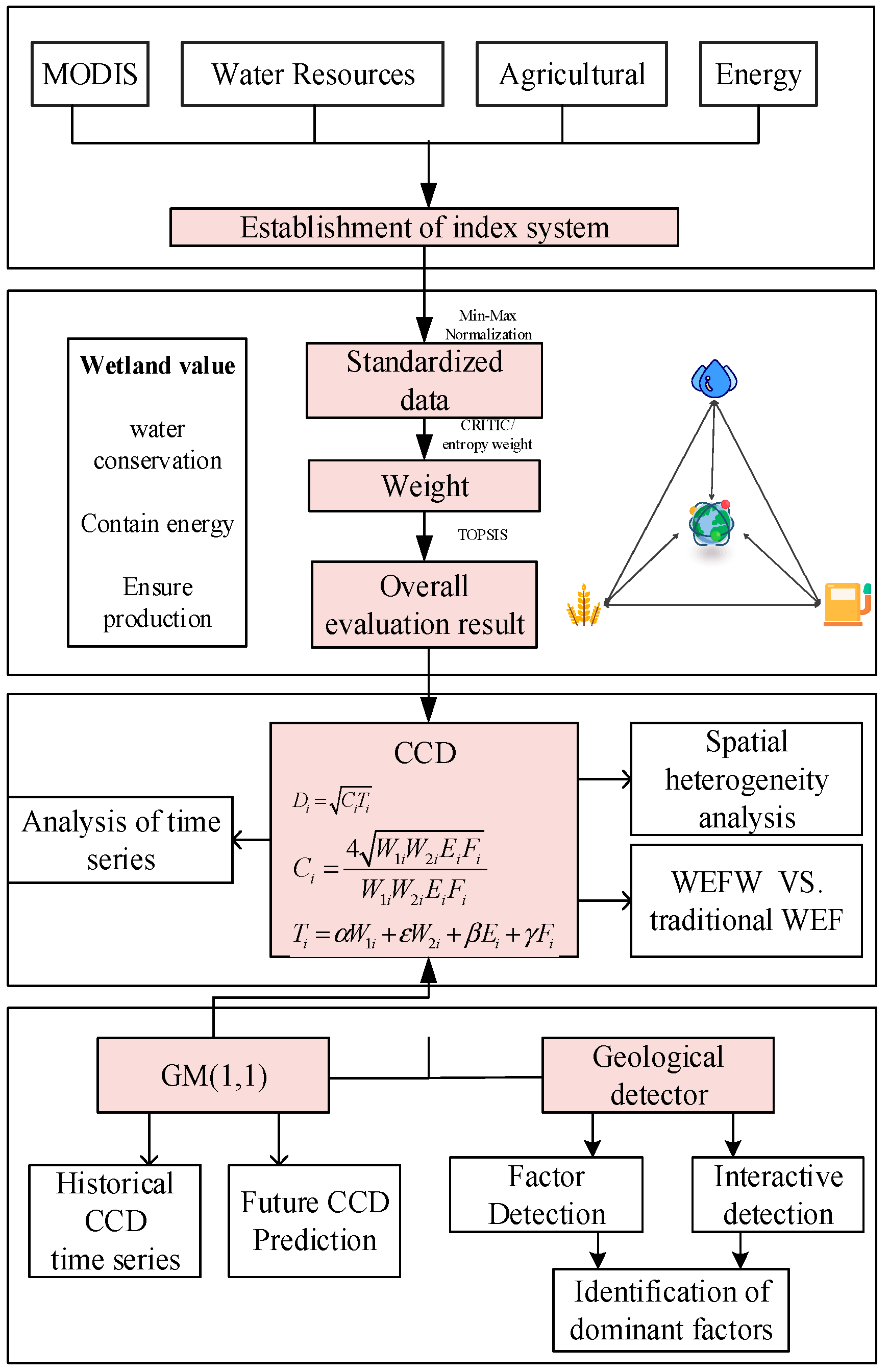
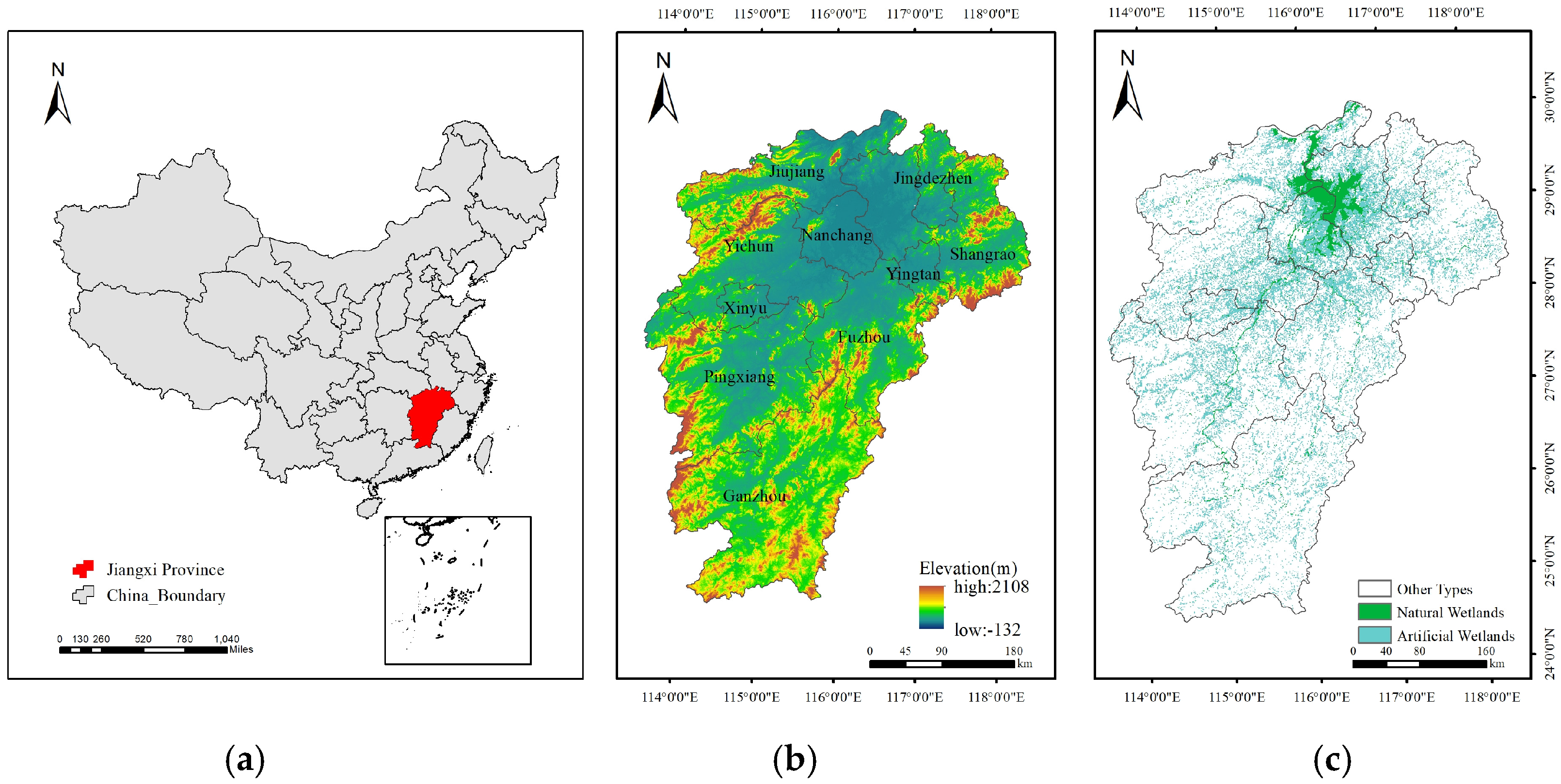
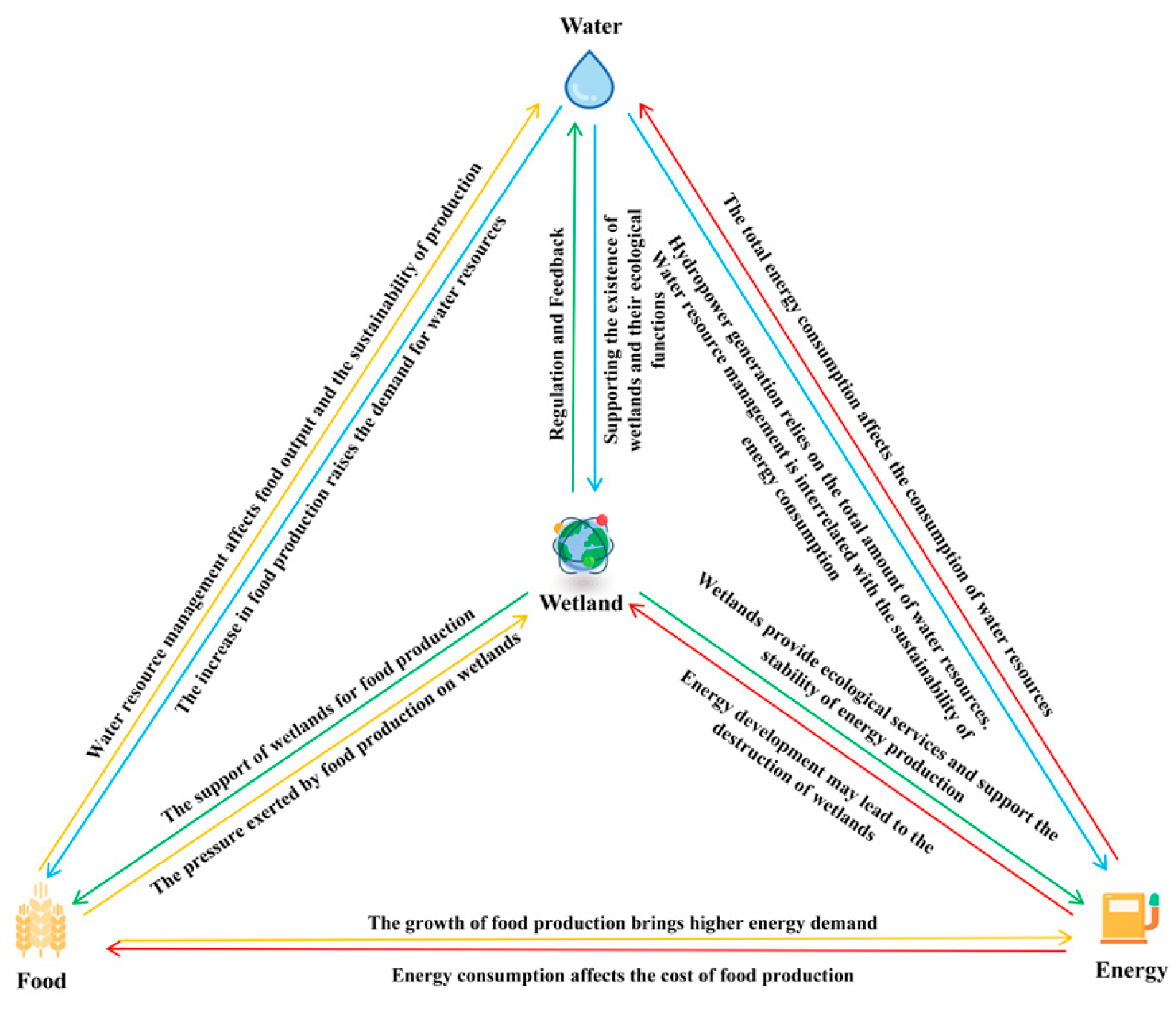
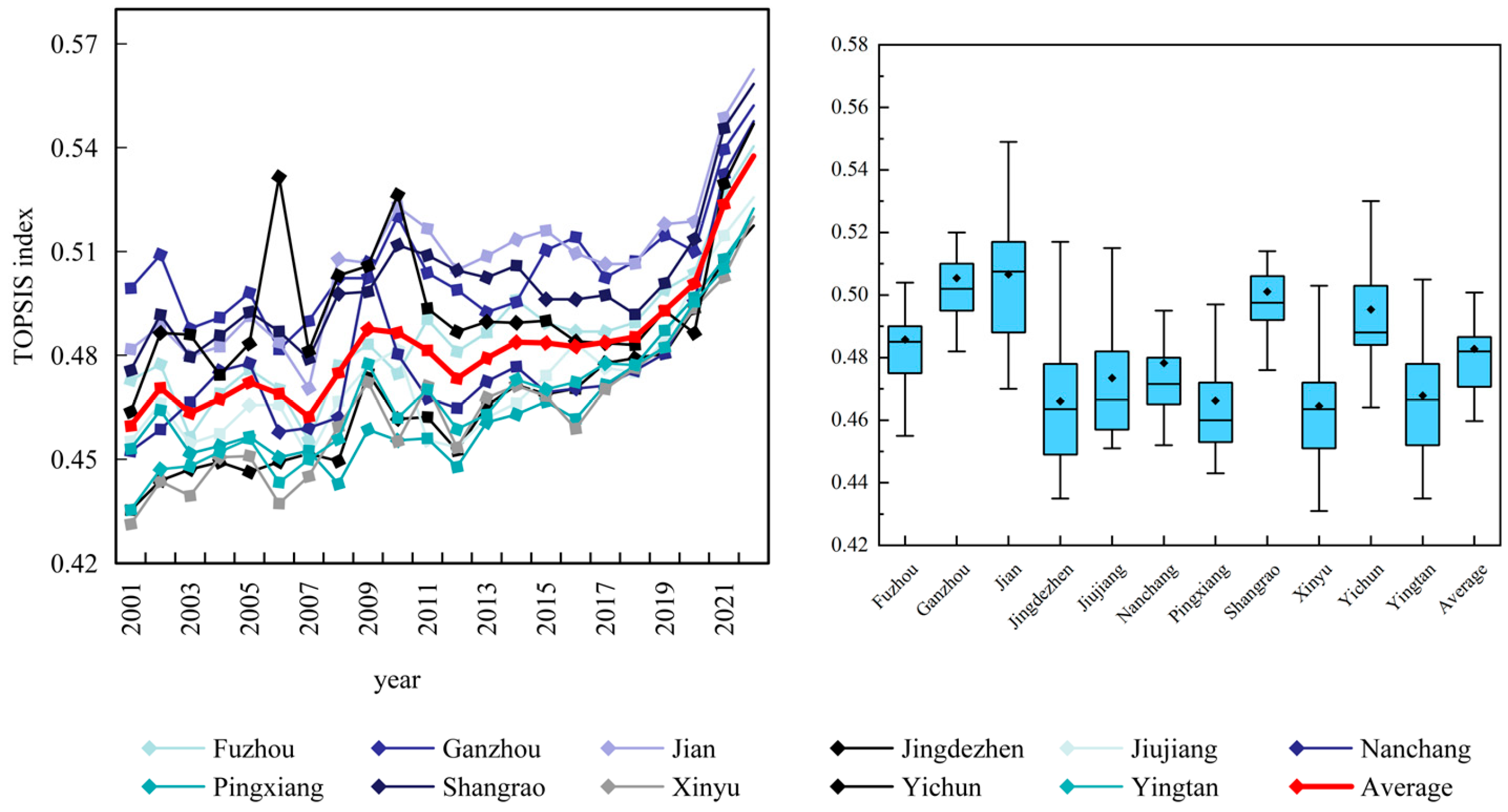
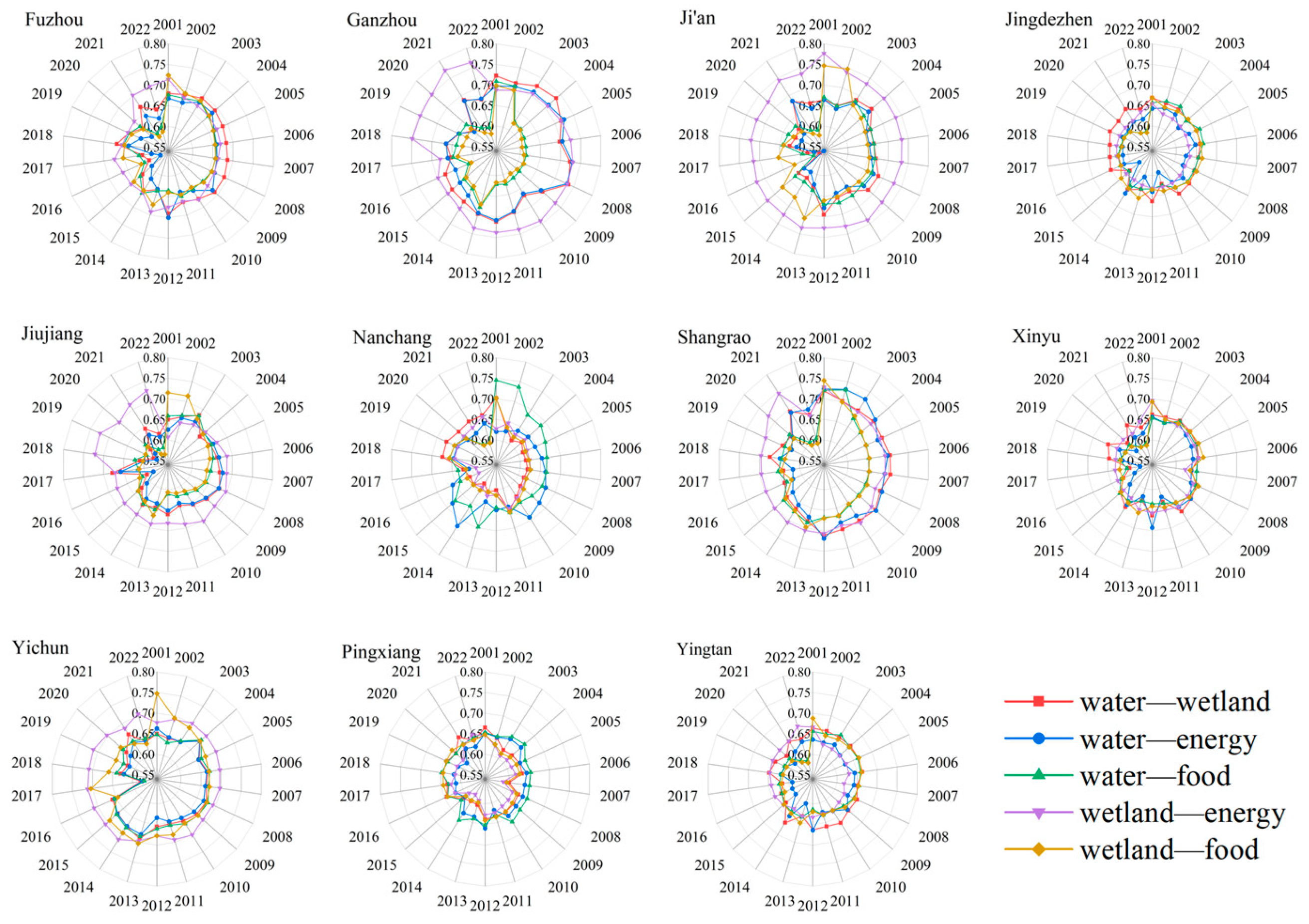
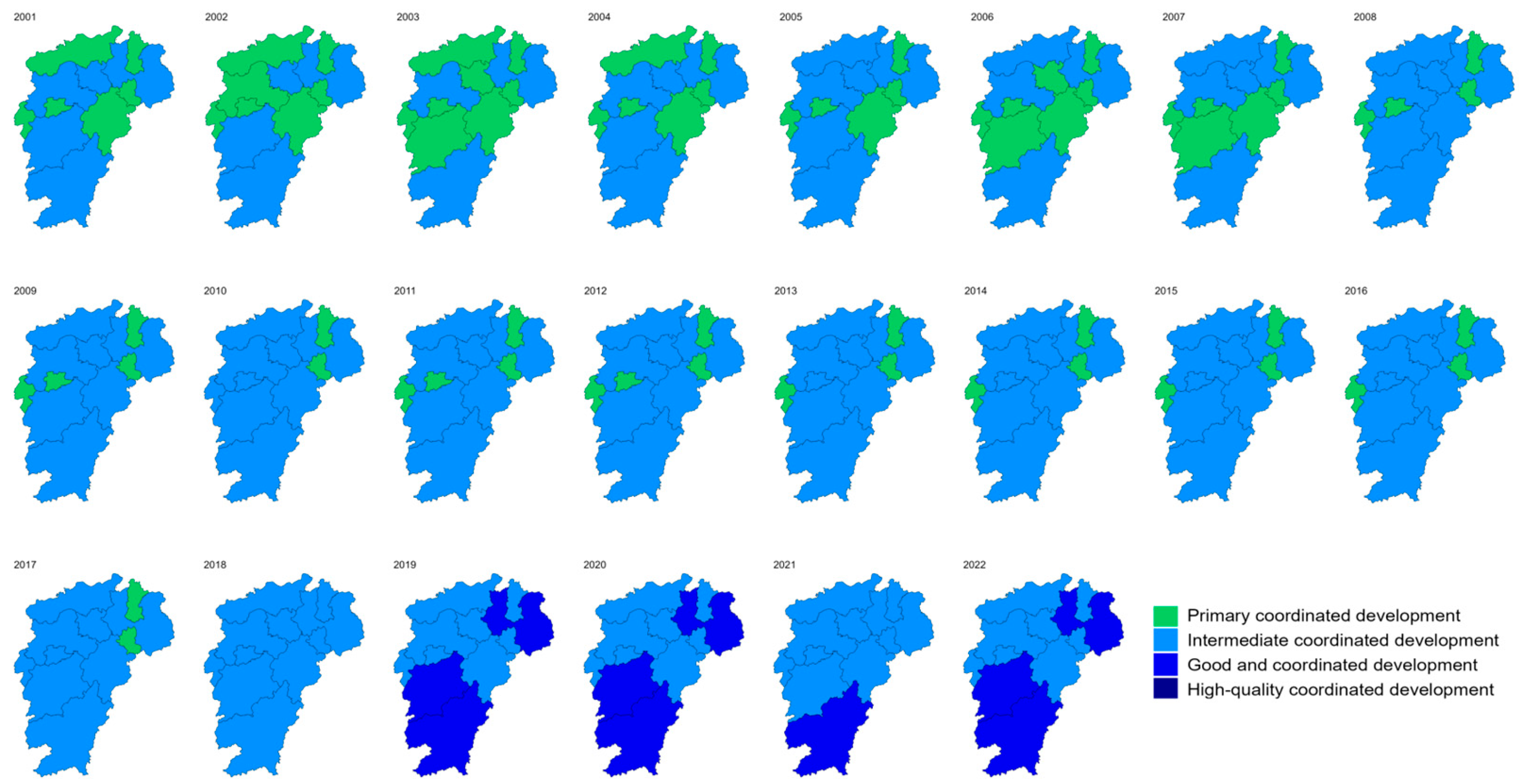

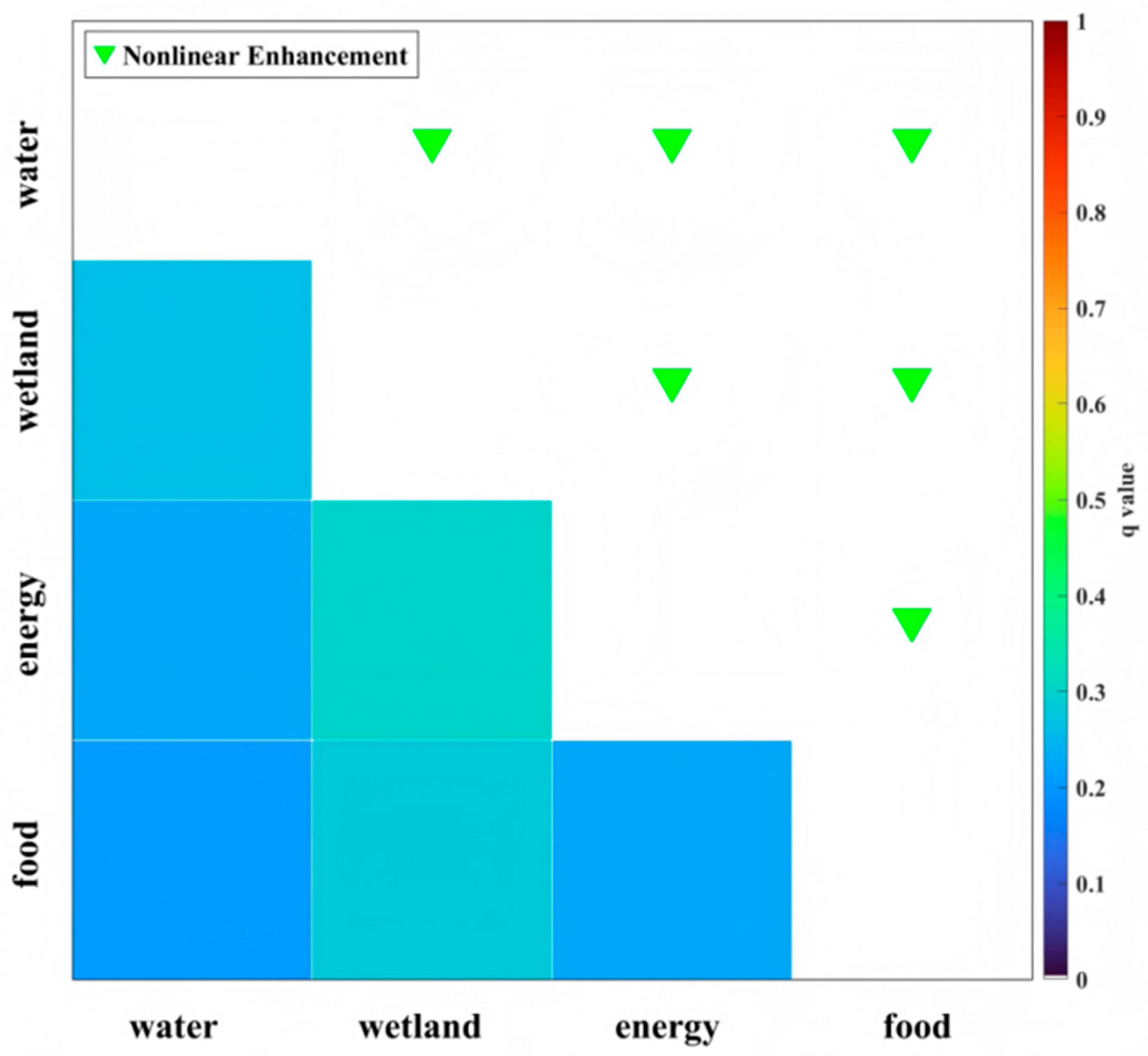
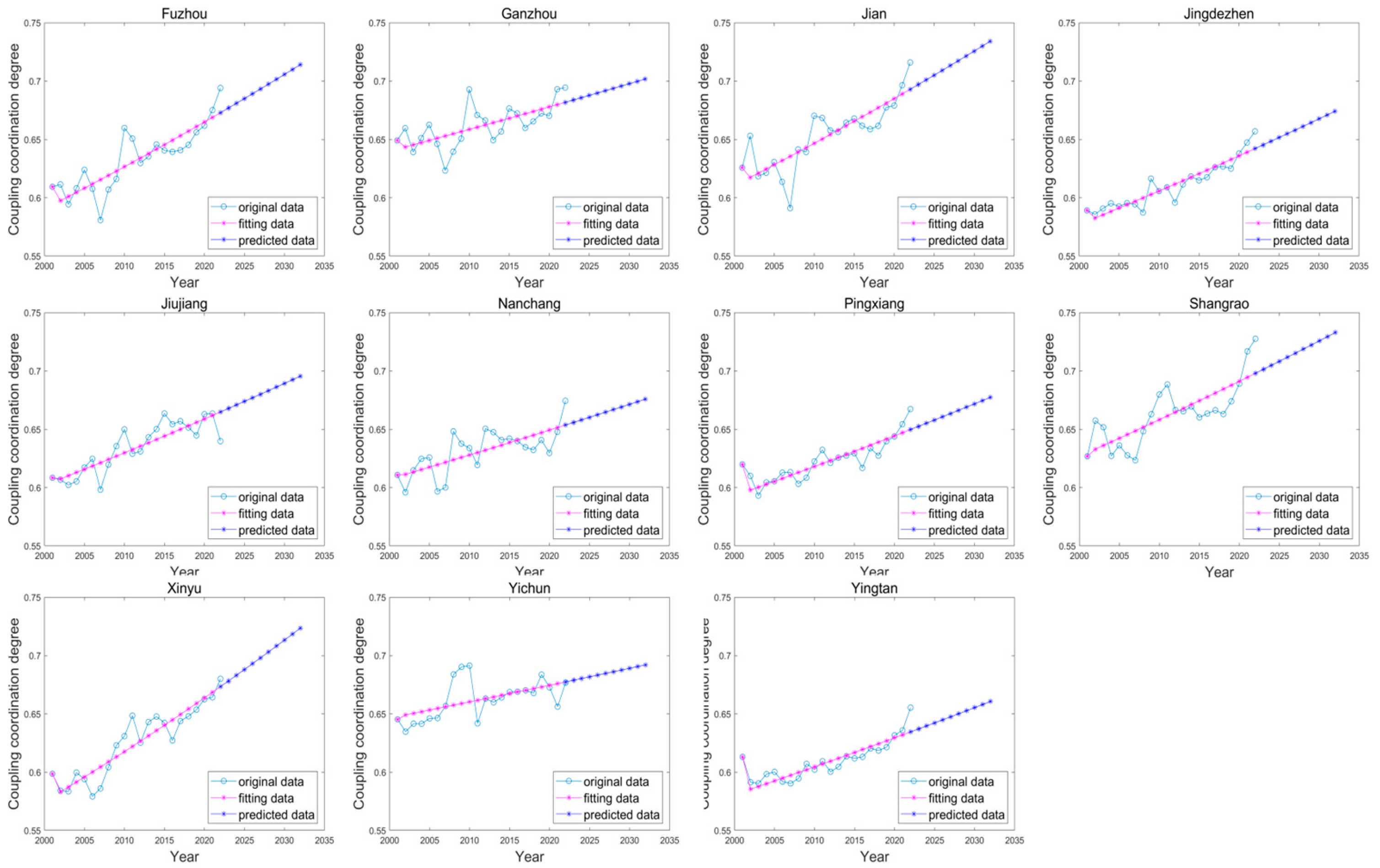
| System Layer | Criterion Layer | Indicator Layer | Type | Code |
|---|---|---|---|---|
| Water Resources Subsystem | Total water resources and their sources | Total water resources | + | W1 |
| Precipitation | + | W2 | ||
| Artificial ecological environment replenishment volume | + | W3 | ||
| Water usage structure and consumption | Industrial water consumption | − | W4 | |
| Urban public water consumption | + | W5 | ||
| Residential water consumption Wastewater treatment rate | + | W6 | ||
| Water resource utilization efficiency and management | Water resource development utilization rate | + | W7 | |
| Total energy consumption | + | W8 | ||
| Energy subsystem | Total energy and growth rate | Average annual growth rate of energy consumption | − | E1 |
| Energy consumption per unit of GDP | − | E2 | ||
| Energy efficiency and development elasticity | Energy consumption elasticity coefficient | − | E3 | |
| Total grain output | − | E4 | ||
| Food subsystem | Food availability | Per capita grain output | + | F1 |
| Grain unit output | + | F2 | ||
| Grain sown area | + | F3 | ||
| Agricultural water consumption | + | F4 | ||
| Effective utilization coefficient of irrigation water in farmland | − | F5 | ||
| Food sustainability | Rural residents’ consumption expenditure | + | F6 | |
| Rural residents’ disposable income | + | F7 | ||
| Natural population growth rate | + | F8 | ||
| Density of wetland patches | − | F9 | ||
| Wetland subsystem | Food sustainability | Wetland aggregation index | + | w1 |
| Total wetland area | + | w2 | ||
| Wetland landscape shape index | + | w3 | ||
| Patch connectivity index | + | w4 | ||
| Ecological functions and diversity characteristics | Shannon diversity index | + | w5 | |
| Total water resources | + | w6 |
| Degree of Coordination | CCD | Coupling Coordination Type |
|---|---|---|
| Degree of coordination | (0.9~1.0] | High-quality coordinated development type |
| (0.8~0.9] | Good coordinated development type | |
| (0.7~0.8] | Intermediate coordinated development type | |
| (0.6~0.7] | Primary coordinated development type | |
| Excessive development category | (0.5~0.6] | Marginal coordinated development type |
| (0.4~0.5] | On the verge of imbalance development type | |
| Disorder and decline category | (0.3~0.4] | Mild imbalance and decline |
| (0.2~0.3] | Moderate imbalance and decline | |
| (0.1~0.2] | Severe imbalance and decline |
| Factor | q | p-Value |
|---|---|---|
| Water | 0.067 | 0.0059 |
| Wetland | 0.142 | 0.0009 |
| Energy | 0.0745 | 0.0159 |
| Food | 0.0574 | 0.0099 |
Disclaimer/Publisher’s Note: The statements, opinions and data contained in all publications are solely those of the individual author(s) and contributor(s) and not of MDPI and/or the editor(s). MDPI and/or the editor(s) disclaim responsibility for any injury to people or property resulting from any ideas, methods, instructions or products referred to in the content. |
© 2025 by the authors. Licensee MDPI, Basel, Switzerland. This article is an open access article distributed under the terms and conditions of the Creative Commons Attribution (CC BY) license (https://creativecommons.org/licenses/by/4.0/).
Share and Cite
Mao, Z.; Xu, L.; Cheng, J.; Jiang, M.; Wang, J. Coupling Coordination Relationship and Evolution Prediction of Water-Energy-Food-Wetland Systems: A Case Study of Jiangxi Province. Land 2025, 14, 1960. https://doi.org/10.3390/land14101960
Mao Z, Xu L, Cheng J, Jiang M, Wang J. Coupling Coordination Relationship and Evolution Prediction of Water-Energy-Food-Wetland Systems: A Case Study of Jiangxi Province. Land. 2025; 14(10):1960. https://doi.org/10.3390/land14101960
Chicago/Turabian StyleMao, Zhiyu, Ligang Xu, Junxiang Cheng, Mingliang Jiang, and Jianghao Wang. 2025. "Coupling Coordination Relationship and Evolution Prediction of Water-Energy-Food-Wetland Systems: A Case Study of Jiangxi Province" Land 14, no. 10: 1960. https://doi.org/10.3390/land14101960
APA StyleMao, Z., Xu, L., Cheng, J., Jiang, M., & Wang, J. (2025). Coupling Coordination Relationship and Evolution Prediction of Water-Energy-Food-Wetland Systems: A Case Study of Jiangxi Province. Land, 14(10), 1960. https://doi.org/10.3390/land14101960








